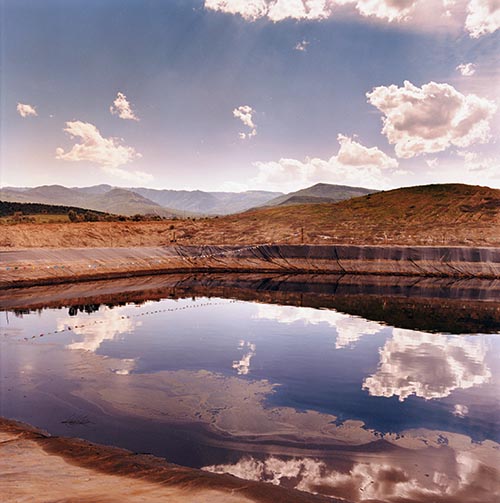



Mark Murrmann, Photo Editor of Mother Jones
April, 2010by Adriana Teresa
Photo by Marcus Bleasdale / VII
Mother Jones is a nonprofit news organization that specializes in investigative, political, and social justice reporting. We currently have two main “platforms”: an award-winning bimonthly national magazine, and a website featuring new, original reporting 24-7.
Mark Murrmann came to Mother Jones with a background as a freelance editorial and documentary photographer, having covered Congress, the Orange Revolution in Ukraine, Hurricane Katrina’s aftermath in New Orleans, and the repercussions of the Balkan wars in the former Yugoslavia. He has also logged thousands of miles on tour, shooting bands and is a regular Hamburger Eyes contributor. Mark studied photography in London in 2004 a winner of the Alexia Foundation Photography Contest. Prior to becoming a photographer, he started a self-published punk magazine in 1991, which led to a weekly column in the Indianapolis Star and a coediting position at Maximumrocknroll, a long-running San Francisco-based punk magazine.
Adriana Teresa: What is contemporary photography within your forum?
MM: The Photojournalism part of the Mother Jones website reflects the same kind of photography we run in the magazine. We focus primarily on documentary work, photo essays and portrait projects. I like to get a mix of work on the site. Very simply, I generally look for great bodies of work that tell a story. That can be something like Danny Wilcox Frazier’s amazing “Driftless” series on Iowa, Anthony Karen’s work on the Ku Kux Klan or Ellena Dorfman’s “Fandomania” project. A lot of work we feature on the site is an expanded version of work we ran in the magazine, but we do run work that only appears on the site. There’s more flexibility in terms of how many images, what the story is and how it’s told. We get so many incredible photo essay submissions and really only have room to run about six a year in the magazine. It’s nice to have an extra outlet for some of that work we can’t publish in the printed magazine. We’re working on building it out more—bigger images, more photo essays.
AT: What do you look for in a photographic series or a photographer today that you didn’t look for three years ago?
MM: I’m constantly on the lookout for something fresh, unique. That’s always been the case, but recently I think I’ve been looking for photographers who are pushing the boundaries of how to tell stories with photos. That can be how they approach telling the story, how they actually shoot, or even the kinds of stories they’re working on. It’s refreshing to see work that does more than just show the reader something that’s wrong with the world. I also like working with younger photographers to give them a chance to get their work seen.
AT: What is the goal of your online Forum in regards to Photography? Why is this your focus?
MM: The goal of the photojournalism part of the website is, at this point, largely to expand on the kind of work we showcase in the magazine. I wish we had a bigger budget to do more with the photography on the site, make it a real photography destination.
AT: What would you say is the most significant progression in photography today?
MM: The proliferation of online photo magazines (like Visura) and photo sites such as the New York Times‘ Lens blog, as well as a photographer’s own blog have probably been one of the biggest and most fun progressions recently. A lot of the really excellent work has an outlet, and there are a lot of interesting discussions about photography happening among various blogs.
AT: How important is having an online presence for photographers today as a resource to share their work?
MM: Having an online presence is essential for photographers today. Websites are good, really a basic part of being a working photographer today. But it is just a start. A lot of photographers (good ones as well as plenty of mediocre ones) are getting attention because they have interesting or entertaining blogs. Being able to keep up with a photographer’s regular work, getting an insight into their personality and working style and just getting a feeling of knowing them a little goes a long way. Of course, once every photographer gets a blog in addition to a website it’ll be too much to keep up with…which is why aggregating blogs (such as The Photography Post, Resolve, Rachel Hulin’s blog, etc.) are so great. Luceo Images makes for a great example of having a strong web presence. They are one of the more talented groups of young photographers around, and also one of the smartest in terms of pushing the envelope, making a strong presence on the Internet.
AT: What parameters would you like to transcend?
MM: I think Mother Jones has the potential to be an online photo destination for great photography, but getting to that point is challenging. I’m a one-person photo department and web staff, as well as the rest of the art staff has other, bigger priorities right now. But it’s something on my radar. There’s so much that can be done…finding a sweet spot between sites like Visura, A Photo Editor and Conscientious, that is showcasing top-notch work, having an insiders perspective on photography and smart, critical thinking about photography in general. That’s sort of my dream for the photography part of the Mother Jones website. For now I’d settle for just having a little extra time and money to be able to share more of the killer photography that passes my desk every day.

Photo by Christopher LaMarca
—
Originally published on theNew York Photo Festival blog